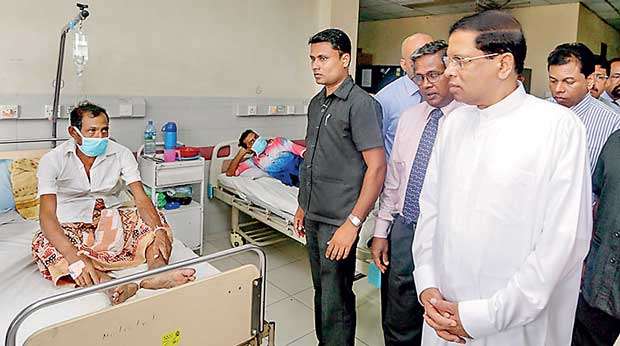24 Jul 2018 - {{hitsCtrl.values.hits}}

 A landmark in Sri Lanka’s fight against kidney disease due to unknown causes, known in medical language as Chronic Kidney Disease of Unknown etiology (CKDu) was created on July 21, when the President of Sri Lanka, Maithripala Sirisena, laid the foundation of the National Nephrology Hospital in Polonnaruwa, in the North Central Province.
A landmark in Sri Lanka’s fight against kidney disease due to unknown causes, known in medical language as Chronic Kidney Disease of Unknown etiology (CKDu) was created on July 21, when the President of Sri Lanka, Maithripala Sirisena, laid the foundation of the National Nephrology Hospital in Polonnaruwa, in the North Central Province.
The largest kidney hospital in South Asia, which is being built with a grant of LKR 1.2 billion (US$ 7.6 million) from China, will have state-of-the-art equipment, beds for 200 patients, 100 dialysis machines, six modern operating theatres, and residential facilities for the staff. The hospital is expected to come up in 24 months.
The hospital is the brainchild of President Sirisena, who has been deeply concerned about the wide prevalence of CKDu in Polonnaruwa, which is both his native district and political base.
Chinese Ambassador, Cheng Xueyuan, said that the hospital would “be a major kidney treatment centre in the region and will certainly be a major event in the history of Sino-Lankan relations.”
According to the Sri Lankan Presidential Task Force on CKDu, CKDu is a widespread disease caused by wide range of precipitating factors. According to available health statistics, there are over 28,000 admissions or re-admissions of patients with renal failure in Government hospitals with approximately 5,000 deaths annually.
CKDu is a toxic nephropathy causing tubular necrosis. CKDu differs from the pathophysiology of CKD caused by hypertension and diabetes.
It was first detected in the early 90s in the North Central Province. Subsequently, it has been found in the Ampara, Badulla, Kurunegala, Matale, Mullaithivu, Trincomalee and Vavuniya Districts as well.
Sirisena’s “Extraordinary Contribution”
For the steps he had taken to tackle the scourge, affecting mostly poor farmers in his native district, Sirisena was given an award in December 2016 by the International Society of Nephrologists (ISN).
It was given by the ISN President, Prof. Adeera Levin, at a function to launch the ISN-Gardiner Fund (ISN-GF), a private initiative meant to fight CKDu not only in Sri Lanka but the South Asian region and the world at large.
Levin said that the Sri Lankan programme to fight against CKDu is the “first national level program in the world.”
The Sri Lankan model emphasizes not only treatment but prevention, care of patients and their families, research and education. The program is coordinated and led by a Presidential Task Force.
Public-Private Model
Breaking away from past practice, President Sirisena has included the private sector through the Sanjeev Gardiner Foundation in his fight against CKDu.
The Gardiner Fund (GF) is a Sri Lankan fund initiated by Sanjeev Gardiner, the well-known entrepreneur and proprietor of the iconic Galle Face Hotel in Colombo. In 2015, President Sirisena had appointed Gardiner as the Ambassador for the fight against CKDu.
Gardiner set up the Gardiner Fund with a personal contribution of LKR 30 million. It has set up Reverse Osmosis (RO) plants in the affected areas for people to drink purified water as impure water is said to be one of the causes of CKDu.
The task handled by the Gardiner Foundation is huge. According to Sanjeev Gardiner, CKDu is endemic among poor farmers in 11 districts and villages under 60 Divisional Secretariats in Sri Lanka.
“With 20,828 patients and 5000 deaths per year, CKDu is a national disaster,” he says.
The Anuradhapura and Polonnaruwa Districts in the North Central Province (NCP) have the bulk of the patients with 9,005 and 4,369 respectively. Kurunegala, Matale and Vavuniya have over 1,000 cases each.
Families Of Patients
Looking at the disease from a people’s representative, Sirisena has stressed the need to look at the economic impact of CKDu on the families of indigent farmers.
“Apart from treating patients, the government and others involved in the eradication of CKDu should take steps to alleviate the suffering of the patients’ families,” the President has said.
This is why under the Sri Lankan national programme envisages the building of houses, the grant of educational scholarships and aid for self- employment.
According to Dr Chula Herath, President of the Sri Lanka Association of Nephrologists, Sri Lanka has come a long way since the 1980s when there were only two nephrologists in the island. Now as many as 350 transplants are done every year.
The Sri Lankan Presidential Task Force on Prevention of Chronic Kidney Disease is engaged in formulating a National Plan or Policy for eradicating CKDu. It is to promote inter-ministerial, departmental and institutional coordination; intervene in legal and policy matters; ensure the welfare of patients and their families; facilitate, supervise, guide and review all activities in regard to CKDu.
A critical task of the Presidential Task Force is to crack the ‘u’ or the ‘unknown’ aspect of the Chronic Kidney Disease of Unknown Etiology (CKDu). The disease has been identified and treated to an extent, but if the cause is unclear, and that is the case despite a great deal of research, treatment and prevention cannot be effective.
Existing Findings
Rajapakse, S, Shivanthan MC, Selvarajah in their 2016 paper (https://www.ncbi.nlm.nih.gov/pubmed/27399161) say that in Sri Lanka, the incidence of CKDu is highest in the North Central Province (NCP), where approximately 45 % of the country’s paddy fields are located.
During the past decade, a number of groups have investigated this disorder using different methodologies and reported various correlations, but have failed to find “a” cause.
“Several nephrotoxins prevalent in the region, including medications, leptospirosis, toxic herbs, illicit alcohol, locally grown tobacco, and petrochemicals, as well as the effects of changed habits which have occurred over the past four decades, have not been studied to date.”
“However, taken together, the geographical distribution and overall findings indicate that combinations of factors and/or their interactions are likely to precipitate CKD-mfo.”
“Much anecdotal evidence from this region suggests that consumption of contaminated water is the most likely source.”
“Irrigation systems with demonstrable seepage to the wells are correlated with CKDu compared to communities without irrigation seepage into wells,” the researchers say.
“High levels of cadmium and fluoride, and complex interactions between the ratio of dissolved sodium and calcium in the presence of fluoride have been hypothesized to cause CKDu. However, the results have been mixed. In another recent important study, subjects from endemic regions had higher concentrations of excreted heavy metal and glyphosate in the urine, exceeding the reference range,” the authors of the paper said.
Prevention Easier
 Although the aetiology is unknown, prevention seems relatively straightforward, the authors say.
Although the aetiology is unknown, prevention seems relatively straightforward, the authors say.
“Solutions include (a) preventing environmental pollution, (b) stopping the irresponsible use and decreasing the usage of agrochemicals, and encouraging the use of environmentally friendly agricultural methods, (c) taking proper precautions when using agrochemicals and safe disposal of their containers, (d) changing the risky behavior of farmers and educating them to preserve the environment, and (e) providing clean potable water to all affected regions.”
28 Oct 2024 1 hours ago
28 Oct 2024 2 hours ago
28 Oct 2024 5 hours ago